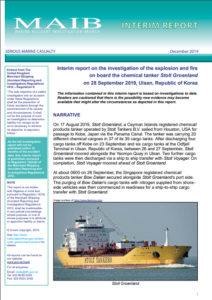The UK MAIB issued an interim report concerning an explosion and fire on board the chemical tanker Stolt Groenland which occurred that day in Ulsan, Republic of Korea, looking for the factors that caused the explosion.
The Incident
On August 17, 2019, the Cayman-Islands registered chemical tanker Stolt Groenland began its voyage from sailed from Houston, USA for passage to Kobe, Japan via the Panama Canal. At the time, the vessel was transmitting 02 different chemical cargoes in 37 of its 39 cargo tanks.
After discharging four cargo tanks of Kobe on 23 September and six cargo tanks at the Odfjell Terminal in Ulsan, Republic of Korea, between 26 and 27 September, Stolt Groenland moored alongside the Yeompo Quay in Ulsan. Two further cargo tanks were then discharged via a ship to ship transfer with Stolt Voyager. On completion, Stolt Voyager moored ahead of Stolt Groenland.
On September 28, the chemical/ products tanker Bow Dalian secured alongside Stolt Groenland’s port side. The vessel commenced its purging of Bow Dalian’s cargo tanks with nitrogen supplied from shoreside vehicles in readiness for a ship-to-ship cargo transfer with Stolt Groenland.
Yet, later on, vapour started being released from the pressure vacuum valve for Stolt Groenland’s number 9 starboard (9S) cargo tank, whereas later a high level alarm was sound marking that the level in 9S cargo tank had reached 95%, soon followed by a high-high-level alarm indicating that the level had increased to 98%.
By that time, Stolt Groenland’s on-watch deck officer and chief officer had made their way to the cargo control room and they saw from the cargo monitoring system that the pressure inside 9S cargo tank was rapidly rising.
Suddenly, two explosions were seen and heard in rapid succession in way of the tanker’s cargo manifold. The resulting fireball passed very close to a road bridge above the quay.
The incident resulted to the injury of crewmembers and other people working at the area. Specifically, Stolt Groenland’s gangway watchkeeper, who was blown over the guardrails by the force of the explosion; a deck rating on board Bow Dalian; and, a number of shore workers, including firefighters and police during the emergency response.
Initial Findings
According to the interim report of the UK MAIB, the first findings of the investigation are the following:
- The explosions on board Stolt Groenland were probably caused by the rupture of the deck above 9S cargo tank, followed immediately by the ignition of the styrene monomer vapour that was then released. The rupture was due to over-pressurization and the likely sources of the ignition were static electricity, sparks or elevated steel deck plate temperatures resulting from the tank rupture. A large hole was found in way of the tank’s common bulkhead with number 9 centre (9C) cargo tankand its hatch cover had been blown off. No cargo operations or deck maintenance were in progress at the time. VDR data showed that the temperature of the styrene monomer had reached 100ºC at the time of the explosion. Such an elevated temperature indicates that the cargo was polymerizing.
- Stolt Groenland had loaded 5,250 tonnes of styrene monomer at the LBC terminal in Houston, U.S.A. between 7 and 8 August. Prior to loading, the tanks had been washed and inspected and wall wash tests had been conducted, with no problems being reported. The tanks were not purged with nitrogen before loading and none were adjacent to heated cargoes in accordance with cargo loading instructions.
- The concentration of TBC inhibitor in the styrene monomer in the shore tank was 11.3ppm but this was increased by the addition of 3 US gallons of liquid TBC to each of the destination tanks before loading was commenced. The target concentration of the TBC was 17ppm. The loading was overseen by an American Cargo Assurers cargo surveyor acting on behalf of the supplier of the styrene monomer, Ineos Styrolutions, and the purchaser, Samsung C&T Corporation.
- The certificate of inhibitor stated that the TBC should remain effective for between 60 and 90 days. It also stated that the inhibitor was oxygen dependent and that the ideal temperature for the styrene monomer was between 60ºF and 85ºF (15.5ºC – 29.4ºC). Stolt Groenland did not carry additional inhibitor.
Actions taken
Following the fire incident, Stolt Tankers B.V. engaged salvors to assist in making Stolt Groenland safe. The discharge of the remaining chemical cargo from the tanks that were undamaged was completed by the company’s personnel.
To explore more click herebelow































































